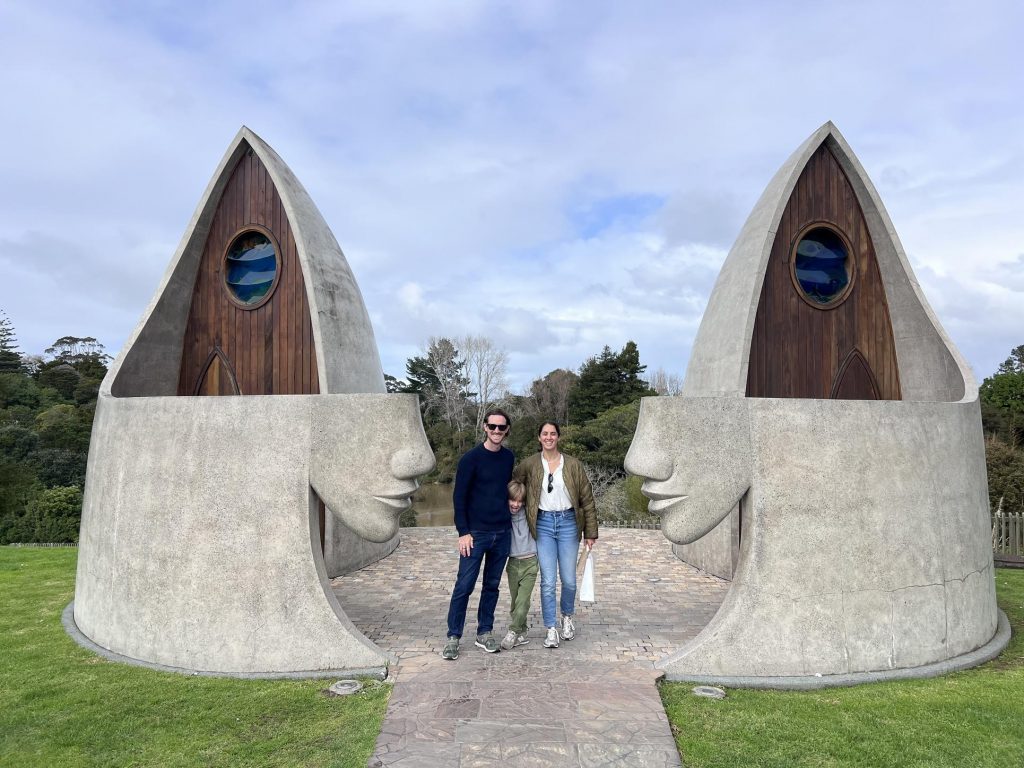I told my family we were stopping to see a bathroom.
My seven-year-old looked confused. “Why would we do that?”
Fair question. “It’s supposed to be really cool. Famous, even.”
“Bathrooms can’t be famous.”
“Well, this one is. Apparently.”
The whole drive over, I was second-guessing the decision. We only had so many days in New Zealand, and I’d just burned forty minutes of our itinerary on… what, exactly? A toilet with good reviews? My husband didn’t say anything, but I could feel the skepticism radiating from the driver’s seat.
Then we got there. And okay. I get it now.
The Matakana Toilets—and yes, they have a name, which should tell you something—don’t look like bathrooms. They look like art: two massive wooden structures shaped like upside-down boat hulls, all curves and timber beams and these carved faces staring out at you. There were probably twenty people milling around when we arrived taking photos of public restrooms. We immediately joined them.
It’s hard to explain why they’re so striking in person. You walk inside and instead of the usual fluorescent grimness, there’s this cathedral feeling with wooden ribs arching overhead, and curves that just feel effortless. The faces built into the walls aren’t creepy, exactly, but they’re definitely watching you. Not exactly what you’d think would be a good thing when it comes to bathrooms, but it just made it all the more cool.
The man who designed them, Steffan de Haan, was 19 and a first-year architecture student at Auckland University. The village held a design competition in 2002 and this teenager’s concept beat out everyone else’s. His whole idea was based on Matakana‘s boat-building history.
It took forever to build—seven years from design to opening—but when the toilets finally appeared in 2009, people started making little pilgrimages. Which sounds dramatic, I know, but there I was, crouched at odd angles trying to get the light right for photos. Of a bathroom.
What I didn’t expect was how much I’d like Matakana Village itself. The bathrooms get the headlines, sure, but the place around them is the real surprise: small in the best possible way. We wandered for hours, slipping in and out of galleries that actually show local art, not mass-printed seascapes. The shops sell handmade ceramics, olive oil, thick wool blankets — things that feel like someone actually touched them. Nothing pushy, nothing fake. Just… nice.
We missed the farmers’ market by a day—everyone we met mentioned it, which made it worse—apparently it’s the Saturday thing here. Produce, baked goods, flowers, the kind of market where you go for carrots and somehow come home with jam, pastries, and a lighter wallet. Even the café food was better than it had any right to be. Fresh in that quiet way that tells you someone picked it that morning.
Here’s the thing about those toilets: they’re not just a quirky photo op. They’re a signal of how this place operates. When Matakana needed public restrooms, they could have thrown up a basic concrete block like every other town. Instead, they held a competition, picked a design that honored local history, and waited seven years to do it right. That same approach seems to apply to everything here—the shops, the food, the market, the way they’ve grown without turning into a tourist trap.
The village has figured out how to attract visitors without becoming something unrecognizable to the people who actually live here. That’s rare. Most places either stay too small and struggle, or they blow up and lose whatever made them special in the first place. Matakana seems to have found a middle path.
We spent about a couple of hours there when I’d planned for twenty minutes. My seven-year-old asked when we could come back on the drive away. My husband bought wine and I bought a necklace for my best friend’s birthday created by a local artisan.
So yes, we drove out of our way to photograph a public restroom. And yes, I’d do it again. But mostly because those ridiculous, beautiful toilets are the perfect excuse to discover a village we would have otherwise driven straight past. The bathrooms get you there. Everything else is why you stay.

